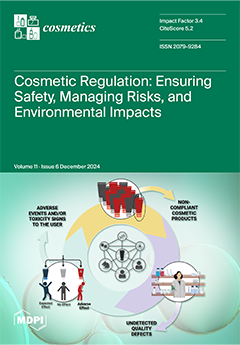Tecoma stans belongs to the Bignoniaceae family and possesses various pharmacological activities, including antimicrobial, anti-inflammatory, antifungal, antioxidant, and wound-healing activities. Although numerous studies have highlighted the beneficial effects of
T. stans extracts, the impacts of different solvents on its biological activities, particularly its
[...] Read more.
Tecoma stans belongs to the Bignoniaceae family and possesses various pharmacological activities, including antimicrobial, anti-inflammatory, antifungal, antioxidant, and wound-healing activities. Although numerous studies have highlighted the beneficial effects of
T. stans extracts, the impacts of different solvents on its biological activities, particularly its inhibitory effect on skin degradation enzymes (collagenase, elastase, and hyaluronidase assay), have not been reported. This study aims to explore the effects of different solvent extractions on the total phenolic and total flavonoid contents, antioxidant and anti-aging activities, and cytotoxicity. The most suitable extract was selected for incorporation into an anti-aging product.
T. stans flowers were extracted using hexane, ethyl acetate, absolute ethanol, and deionized water through maceration. The aqueous extract yielded the highest extraction efficiency (40.73%), followed by absolute ethanol, ethyl acetate, and hexane. The phytochemical screening results revealed that all
T. stans flower extracts contained phenolics, flavonoids, terpenoids, and alkaloids. Among the various solvents tested for
T. stans flower extraction, absolute ethanol demonstrated the highest total phenolic content (24.10 ± 2.07 mg gallic acid equivalents (GAE)/g extract), followed by deionized water (20.83 ± 1.28 mg GAE/g extract). The highest total flavonoid content was observed in the ethyl acetate extract (205.11 ± 7.83 mg catechin equivalents (CE)/g extract), with ethanol showing a significantly lower concentration (140.67 ± 1.92 mg CE/g extract). In terms of antioxidant activity, the aqueous extract exhibited the most potent effects, with IC
50 values of 0.600 ± 0.005 mg/mL for the DPPH
• assay and 0.207 ± 0.001 mg/mL for the ABTS
•+ assay. For anti-aging assays, the absolute ethanolic extract demonstrated the highest enzyme inhibition activity at 1 mg/mL, with collagenase, elastase, and hyaluronidase inhibition rates of 89.49% ± 2.96%, 94.61% ± 2.33%, and 82.56% ± 2.27%, respectively. Moreover, at a concentration of 50 µg/mL, the absolute ethanolic extract exhibited lower cytotoxicity, with human keratinocyte (HaCaT) cell viability of 78% ± 8.47%, which was significantly higher than that of the other extracts. An anti-aging gel containing 0.05%
w/
w of the ethanolic
T. stans extract demonstrated physical and physicochemical stability during three months of storage at ambient temperatures, 4 °C, 45 °C, as well as after six cycles of heating/cooling tests. These findings suggest that the ethanolic extract of
T. stans flower has potential as a safe and effective anti-aging agent for cosmeceutical products.
Full article





